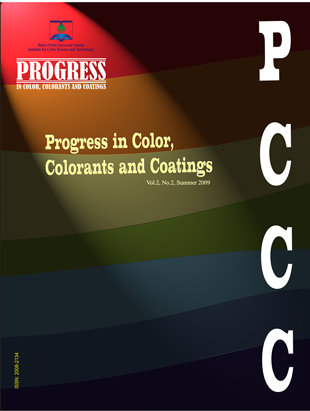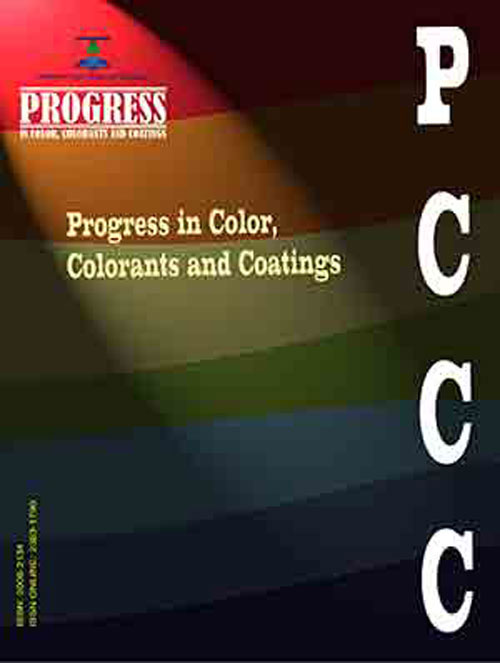فهرست مطالب

Progress in Color, Colorants and Coatings
Volume:2 Issue: 2, Summer 2009
- تاریخ انتشار: 1389/02/15
- تعداد عناوین: 10
-
-
Pages 1-9in this study، a derivative method is applied for the determination of dye concentration in fabrics dyed with tricomponent dye mixtures. The reflectance of spectra of the samples were recorded between 400 and 700 nm. Initially، the obtained (K/S) spectra were divided by the spectrum of a standard sample dyed with two of the components in the ternary mixture and the derivative spectra were calculated. Then، the amounts of the dyes were determined by implementing or carring measurements in suitably selective wavelengths in the required spectra derivative ratio. Results indicated that thedeveloped spectra derivative ratio (K/S) method is more accurate than the normal Kubelka-Munk method.Keywords: Determination, Ternary mixture, Concentration, Ratio Derivative Method, Kubelka, Munk method
-
Pages 19-26in this work، raw fibers of a local species of stabraq (milkweed) were scoured، bleached and blended with cotton fibers with a ratio of 75/25 (cotton/stabraq). The improved stabraq fibers، scoured and bleached cotton and the blended fibers were spun into fine yarns and then they were subjected to dyeing with two types of reactive dyes namely، cold brand and high exhaustion brand reactive dye at 1% omf in a liquor ratio of 20:1، in the exhaustion dyeingmethod. The extent of exhaustion، colour strength and other colorimetric parameters of the dyeing were determined and the results were compared. The results suggested that the dyeability of stabraq fibers with two reactive dyes used، resembles that of cotton yarns more closely، and the blended fibers exhibited superior dyeing behavior than the alone fibers.Keywords: Milkweed, Stabraq, Calotropis Giganteae, Reactive Dyeing, lingo, cellulosic fibers, Mudar fiber
-
Pages 57-63icrowave dyeing was carried out under a variety of conditions in terms of the power and time of a microwave to investigate the effects of microwaving on the dyeability of acrylic fibers. It was found that the dyeability of acrylic fibers were significantly improved under microwave irradiation caused by the increased adsorption of the dye into fibers due to the local over heating and an amplified reaction probability between the dye and fiber. The physical properties of the acrylic fibers were elucidated using scanning electron microscopy (SEM), tensile strength measurements, and differential scanning calorimetry (DSC). The optimum time for the best dye uptake for given microwave powers was also reported.Keywords: Acrylic Fiber, Microwave Dyeing, Cationic dye, Dyeability
-
Pages 71-78niform nanostructure coating of TiO2 was prepared on 316L stainless steel by sol-gel method using Tetra-n-Butyle Titanat (TBT) as alkoxide material. 316L specimens were coated with the mentioned sol by dip coating method. The influences of preparation condition, pH of sol on TiO2 nanostructure coating were investigated. Their structural properties were examined at various calcination temperatures. The effect of drying cycle and solvent bath on crack reduction and the influence of withdrawal speed onthickness of the film was evaluated. Choosing of alcohol as a drying atmosphere could hinder the cracks formation. 400°C was desirable temperature to obtain nanoparticles from anatase phase. At this temperature it was found that TiO2 films exhibited a uniform anatase structure with particle size of about 15 nm. Prog. Color Colorants Coat. 2(2009), Institute for Color Science and Technology.Keywords: Anatase, Nanostructure coating, Sol, gel
-
Pages 79-86In general, the evaluation of automotive coatings appearances favors (is considered preferentially) more than chemical and physical properties. Therefore, its improvement is most required. Studying appearance by means of QMS-BP technique, in which it measures some of the most important coating appearance factors, such as: the specular gloss, distinctness of image (DOI) and orange peel. In this article the influence of variation in the primer properties, such as thickness, roughness and gloss on the appearance of final coating system for two different primer types was studied. Results showed that increase in specular gloss would cause the intensification of NAP (Niveau d’Aspect Peinture) values, while increase in thickness and roughness would decrease it.Keywords: Automotive coatings, Appearance, Roughness, DOE, NAP
-
Pages 87-93Today, natural colorants are emerging globally due to the fact that they are safer and more environmentally-friendly. Natural dyes have been employed in dyeing Persian carpet piles for many years. In this study, the dried Achillea was used for dyeing wool yarns. The Iranian wool yarn was scoured, mordanted using Cu, Sn, Al salts and then dyed with different amounts of dried Achillea powder. Taguchi statistical method was employed to find theeffective factors and results of the planned experiments, in order to optimize thedyeing factors. A L9 orthogonal array (four factors in three levels) was employed to evaluate the effects of different parameters in dyeing process. The colorimetric properties of the dyed yarns were evaluated in CIELAB system. Achillea found to have good agronomic potential as a natural dye in Iran. Dyeing with Achillea in conjunction with metal mordants showed enhancement in its fastness properties. Therefore it shows commercial capability for dyeing of wool yarns used as Persian carpet piles.Keywords: Natural dye, wool dyeing, mordant, Achillea millefolium, Taguchi
-
Pages 95-101To reproduce an image, it is necessary to map out of gamut colors of the image to destination gamut. It is clear that the best color gamut mapping introduces the perceptually closest image to the original one. In this study, a new color gamut mapping is purposed by the aid of Genetic Algorithm (GA). The color difference between the original and mapped images based on SLAB formula was chosen as fitness function. The proposed algorithm was applied in CIELAB color space and special genetic operators were developed to meet the aim of gamut mapping. To increase the rate of convergence and have a faster algorithm, one of the initial population chromosomes can be obtained from the result of clipping method. The results showed that the new method introduces smaller color difference between the reproduced and original images in comparison with the common clipping method. The other advantage of the genetic color gamut mapping is that any new criterion for color image difference can be easily used as a fitness function. In addition, by this method the final colors are not restricted to the gamut surface and they may be included into the gamut. Prog. Color Colorants Coat. 2(2009), Institute for Color Science and Technology.Keywords: Color gamut mapping, Genetic algorithm, Image difference
-
Pages 115-122The corrosion inhibition performance of acetylacetonate complexes of zinc(II), manganese(II), cobalt(II) and copper(II) on the mild steel substrate in 1M H3PO4 was studied using DC polarization. It was seen that the mentioned complexes decreased corrosion rate of mild steel in phosphoric acid media due to the adsorption on metal surface. The potential of mild steel shifted toward more active potentials. The cathodic Tafel slopesincreased showing that acetylacetonate complexes are cathodic inhibitors. Presence of chloride ions in the electrolyte enhanced inhibition performance of acetylacetonate complexes due to synergism. Chloride ions provided by HCl had a better performance compared to NaCl. Prog. Color Colorants Coat. 2(2009), Institute for Color Science and Technology.Keywords: Acetylacetonate complexes, DC polarization, Inhibitor, Synergism effect
-
Pages 123-130In this research, several series of triarylmethane dyes containing one or more terminal methoxy substituents with a variable tertiary amino groups have been used. These dyes have been applied to different substrates by using various methods including transfer printing and then their fastness properties were measured. These dyes shows exceptionally high light fastness (6- 7) on acid modified polyacrylonitrile fibres. Prog. Color Colorants Coat. 2(2009), Institute for Color Science and Technology.Keywords: Triphenylmethane dyes, Acrylic fibres, Fastness properties, Dye application


